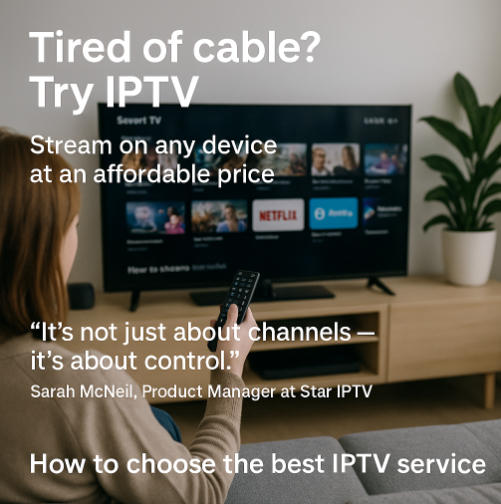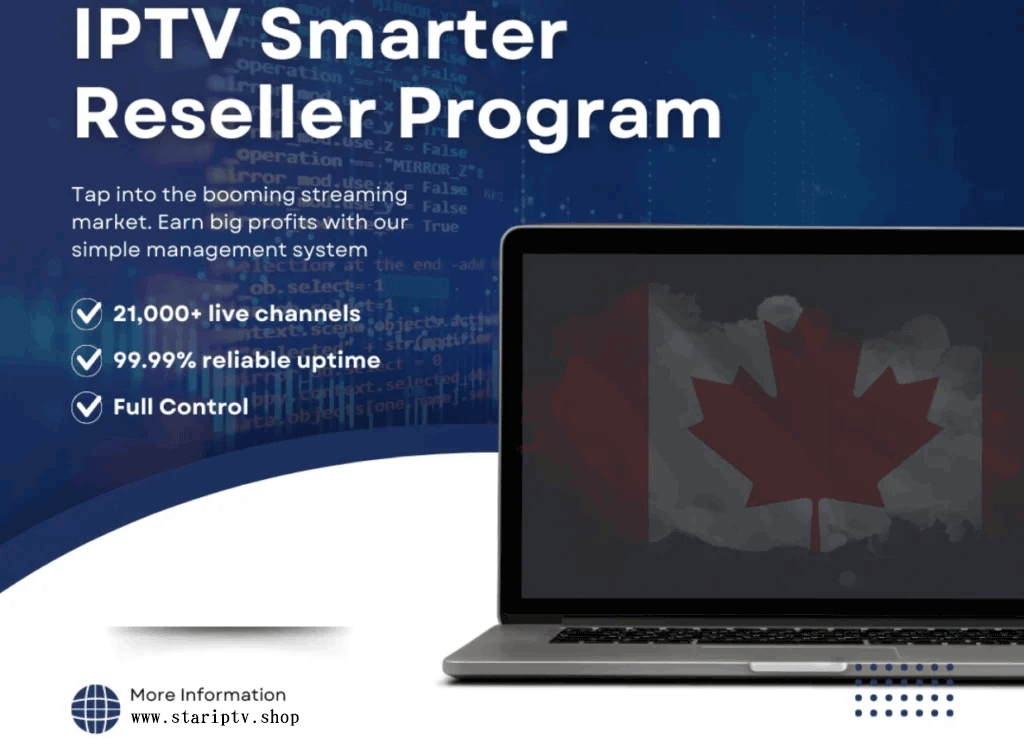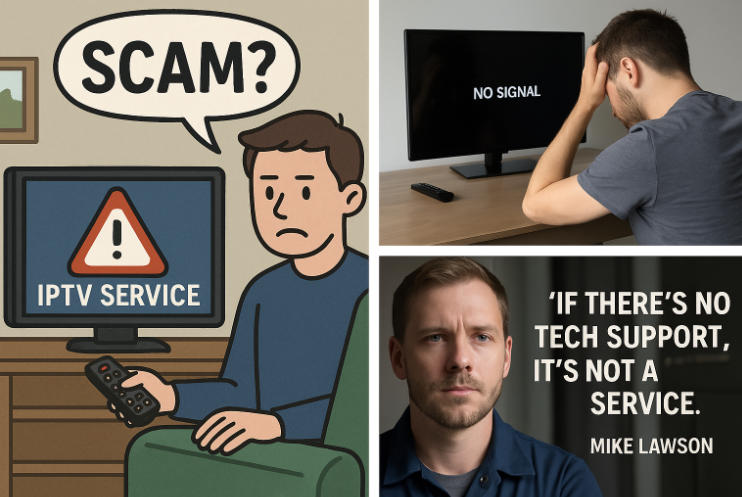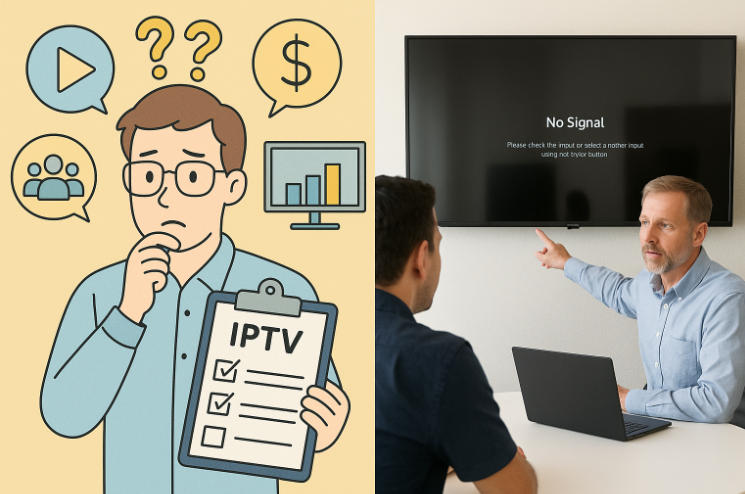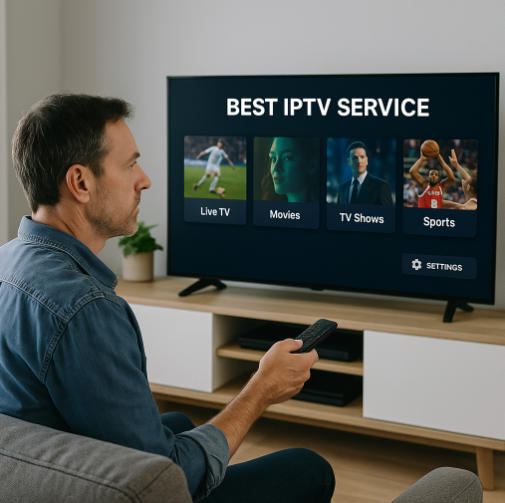Tired of juggling clunky cable boxes, random channel outages, and apps that make you want to toss your remote across the room? You’re not alone. If you're hunting for the best IPTV service that actually does what it promises — works across devices, doesn’t kill your budget, and keeps the content flowing — you’re in the right place. If you want a fast head start, explore our IPTV subscription options and compare IPTV Packages tailored for different needs.
Choosing IPTV isn't just tech talk anymore; it’s about picking a service that fits how real people live. Think about it: your customers stream on smart TVs, tablets, phones, even gaming consoles. If your service isn’t ready for that, you’re already behind. For a refresher on fundamentals, see What is IPTV in our FAQ.
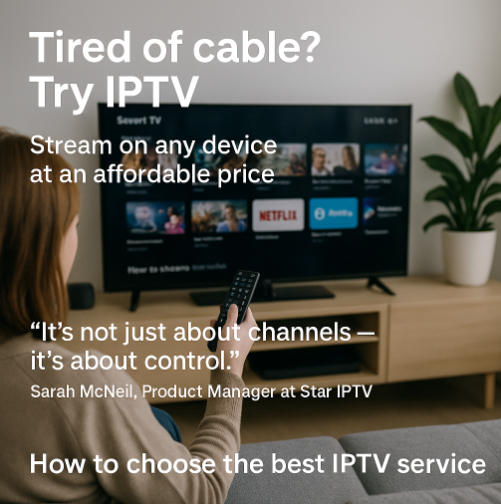
“It’s not just about channels — it’s about control,” says Sarah McNeil, Product Manager at Star IPTV. “Our clients want one platform that works everywhere, with pricing that makes sense.”
This guide keeps it simple: we’ll break down what to look for, compare cable to IPTV, show you how to avoid device nightmares, and spotlight where to get real value for your money.
Let’s skip the fluff and help you pick something that works — for your business and your users.
5 Factors That Define the Best IPTV Service
IPTV Content Variety: From Sports to Documentaries
Let’s be real — no one wants boring, repetitive channels. The content variety is what makes or breaks an IPTV experience.
Sports events like UEFA matches or UFC nights are must-haves for most users.
Documentaries, Movies, and TV Shows? That’s where your long-tail engagement lives.
News programs offer regional and global coverage — IPTV shines here by supporting diverse local feeds.
Bonus: Kids content and music channels round out the package and help you cater to families and niche customers alike.
Offering content that’s both broad and deep makes your IPTV service stand out in a crowded market. If you’re weighing IPTV vs. cable lineups, skim an overview of how IPTV delivery differs from cable’s fixed tiers in this quick guide to IPTV vs Cable TV for context.
Essential IPTV Features: VOD, Catch-Up, and Parental Controls
A solid IPTV service doesn’t just stream content — it gives users control over how and when they watch.
Video on Demand (VOD) lets viewers watch what they want, when they want.
Catch-Up TV gives a second chance to view shows they missed — perfect for users with tight schedules.
Parental Controls are non-negotiable for families, allowing safe, age-appropriate viewing (see official tools on Xbox Family Settings and PlayStation parental controls).
Electronic Program Guide (EPG) provides a clean, browsable layout of channels and content schedules.
Smart recording features can automate daily routines — users never miss their favorite series again.
These features aren’t just "nice-to-haves" — they’re core selling points for any B2B IPTV pitch. For how these map to our platform, check the IPTV streaming section and the quick IPTV setup guide.
Device Compatibility: What Smart TVs and Consoles Can Handle
Here’s where a lot of IPTV providers lose customers — compatibility issues with everyday devices.
Smart TVs are still the go-to for most living rooms. Brands like Samsung and LG are key platforms — see our IPTV setup guide for step-by-step device instructions.
Streaming devices like Fire TV, Roku, and Apple TV dominate bedrooms and smaller screens. Many IPTV players are available; for example, Microsoft’s store lists MyIPTV Player with EPG and M3U support on Windows/Xbox (store listing).
Gaming consoles like Xbox and PlayStation aren’t just for gaming anymore — they support full streaming apps, and consoles offer robust family controls (Xbox family hub, PS controls).
Whether users are on Android tablets or iPhones, seamless multi-device access builds trust and cuts churn.
Compatibility equals convenience. And convenience sells — especially in wholesale.
Having broad device support lets wholesalers promise "plug and play" simplicity to clients.
Streaming Quality Factors: Buffering, Resolution, and Frame Rate
You can have all the features in the world, but if the stream lags or looks pixelated, users bounce — fast.
High resolution (at least 1080p, ideally 4K) gives that crisp, professional-grade experience. For a feel of practical bandwidth, Netflix recommends ~5 Mbps for 1080p and ~15 Mbps for 4K (speeds), while the FCC’s consumer guide lists 25 Mbps for 4K streaming (guide).
Low buffering time is non-negotiable, especially during live sports — modern adaptive bitrate streaming helps by adjusting quality to network conditions.
Frame rate stability matters more than most people realize — it impacts how natural motion feels.
Good quality starts with solid bandwidth and bitrate management on the backend.
Wholesale buyers should test under various internet speeds — your service needs to handle weak connections too.
This stuff isn't just technical fluff — it’s what makes users stay loyal or walk away.
Customer Support Expectations: Live Chat, FAQs, and More
Here’s a major pain point for B2B IPTV providers: offering support that doesn’t suck.
Live chat is the fastest way to help users — no one wants to wait days for an email reply.
FAQs and troubleshooting guides empower users to fix simple issues themselves (ours are centralised in the FAQ).
Email and phone support should be available, but timely responses matter more than fancy systems.
A clear SLA (Service Level Agreement) around support response time is essential in wholesale deals.
Remember: good support doesn’t just solve problems — it builds brand trust.
Best IPTV Service vs Cable: What You Need to Know
Channel Lineups: IPTV or Cable for Live Sports and News
Which gives you the best bang for your viewing time? Let’s find out.
IPTV often offers more global and genre-specific content—great for sports junkies and news hounds.
Cable still provides a solid base of local stations but can feel limited, especially with niche broadcasting.
Here’s how they stack up:
Live Sports Access: IPTV often includes international leagues and real-time streaming of niche sports. Cable can lag behind unless bundled with costly premium add-ons.
News Broadcasting: IPTV services let you access both local and international outlets, even regional language news.
Custom Channel Lineups: IPTV lets you choose; cable locks you into tiers.
For wholesalers, IPTV wins in flexibility and audience segmentation. Offering users curated channel bundles with everything from football to finance? That’s hard to beat. For a broad primer, see this concise IPTV vs Cable comparison.
Cost Breakdown: Monthly Plans, Add-ons, and Discounts
You don’t need a spreadsheet to spot the savings—just follow these steps.
Step 1: Understand your base cost
IPTV typically offers flexible monthly plans that start lower than traditional cable packages (compare our IPTV Packages).
Step 2: Factor in the extras
Add-ons like premium sports, movies, or 4K upgrades are usually optional with IPTV, whereas cable tends to hide them in bundled tiers.
Step 3: Evaluate discounts and promos
IPTV platforms often throw in free trials, seasonal discounts, or referral bonuses—perfect for wholesalers to boost acquisition.
Step 4: Total the value
A cheaper monthly fee doesn’t mean much if you're not getting cloud DVR or VOD. IPTV generally includes these, giving customers more for less.
Viewer Experience: Streaming Stability and Remote Access
Let’s talk experience—not just tech specs.
Buffering issues? IPTV depends on your network. Strong Wi-Fi or wired connections keep things smooth, while poor bandwidth = choppy play. Adaptive bitrate streaming mitigates stalls by switching quality automatically.
Latency? IPTV tech has made big strides, but unstable networks can still create delays in live sports.
Remote access? This is where IPTV shines. Users can stream on mobile during commutes or cast content at hotels—no physical box needed.
Now compare that to cable: it’s location-bound and rigid. If you’re selling IPTV at scale, you’re selling freedom. That matters in a world where people want to watch anywhere, anytime.
Wholesalers, here’s your edge: deliver a better experience, not just a cheaper product.
All-in-One Guide to IPTV Device Compatibility
This guide breaks down how well IPTV works on common devices — a big deal when you're selling to customers who use everything from Firesticks to PS5s.
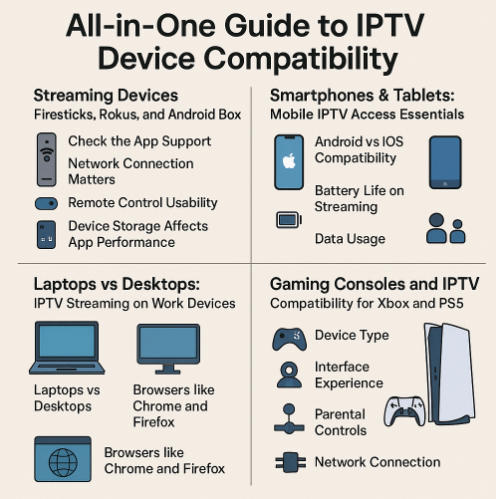
Streaming Devices: Firesticks, Rokus, and Android Boxes
1. Check the App Support
Not all streaming devices are created equal. Fire TV and Roku support most major streaming apps; some Android boxes allow sideloading for flexibility.
2. Network Connection Matters
These devices rely on Wi-Fi, and if the signal drops, so does the stream. Always test stability on your client's network setup.
3. Remote Control Usability
IPTV needs quick navigation — if the remote is clunky (yes, older Rokus, we’re looking at you), customers will get frustrated.
4. Device Storage Affects App Performance
Low-cost boxes may lag due to limited RAM. If the IPTV service includes features like Cloud DVR or VOD, suggest devices with at least 2GB RAM.
Smartphones & Tablets: Mobile IPTV Access Essentials
These devices are often used on the go, making mobile access a must-have. Let’s break it down clearly:
Android vs iOS Compatibility
Most IPTV apps are optimized for both, but Android often allows more customization. iOS tends to limit 3rd-party app installs, so recommend only App Store-approved options.Battery Life on Streaming
Streaming eats battery. Suggest customers use power-saving modes or lower video resolution when streaming on the go.Data Usage
Mobile users might burn through data fast — as a benchmark, Netflix cites ~3 GB/hr (1080p) and ~7 GB/hr (4K) (details).
Laptops vs Desktops: IPTV Streaming on Work Devices
Many clients stream IPTV during work breaks, so compatibility with Windows and macOS is crucial.
Laptops are more flexible due to portability and built-in displays, while desktops usually offer better performance with larger displays and Ethernet stability.
Browsers like Chrome and Firefox tend to handle IPTV web players better than Safari or Edge — worth knowing when offering platform-specific instructions.
Gaming Consoles and IPTV: Compatibility for Xbox and PS5
🔹 Device Type
Xbox and PS5 support major streaming apps; there are dedicated IPTV players on Microsoft’s store such as MyIPTV Player that accept M3U playlists and EPG.
🔹 Interface Experience
Gaming consoles often run streaming smoothly thanks to powerful GPUs, offering a better viewing experience compared to entry-level devices.
🔹 Parental Controls
Parents love the built-in controls on these consoles (Xbox, PlayStation).
🔹 Network Connection
Both consoles support wired connections, which improve stream stability — especially for 4K channels or live sports events.
Best IPTV Service Packages Under $15/month Reviewed
This part explores how much value you can squeeze out of IPTV services while keeping your budget under $15/month. Spoiler: more than you'd expect.
What You Get: VOD, 4K Streaming, and Cloud DVR
Content Library is no joke at this price point. Many providers give you access to:
Popular VOD libraries packed with the latest movies and shows
Full 4K streaming capabilities (as long as your internet can handle it — see speed guidance)
Cloud DVR with basic storage (usually around 20–50 hours)
Resolution varies, but you’ll often get Full HD as a minimum with 4K included on some channels or platforms.
Features like pause/rewind live TV, and even offline downloads, show up more than you'd expect at this price point.
Services in this range are designed to give solid, clean functionality without flashy fluff — think value, not bells and whistles.
Budget IPTV: Free Trials, Add-on Packages, and Promotions
Free Trials: Usually range from 24 hours to 7 days. Enough to test for buffering, VOD availability, and UI performance.
Add-on Packages: Sports packs, kids content, or regional channels — expect $2–$5 per bundle on top of the base price.
Promotions: Common deals include 3-month packages with 1 month free or discounted annual plans.
Discounts: First-time sign-ups often score extra perks or channel upgrades.
Hidden Costs: Data Usage, Subscription Fees, and Support Access
| Provider Name | Monthly Fee | Avg. Data Use (HD/4K) | Free Support Included |
|---|---|---|---|
| StreamMax | $11.99 | 3GB/hr / 7GB/hr | Email + FAQ |
| ViewGo | $9.99 | 2.5GB/hr / 6GB/hr | Live Chat |
| ClarityCast | $13.50 | 3.2GB/hr / 7.2GB/hr | Email Only |
📶 Data Usage can spike — especially with 4K. As a reference point, Netflix documents ~3 GB/hr for HD and ~7 GB/hr for 4K (see figures).
💸 Subscription Fees sometimes exclude regional taxes or service charges — always read the billing terms.
☎️ Support Access is where some low-cost providers cut corners. Live chat or 24/7 phone support might be missing unless you upgrade.
So even if the price tag says "$12," remember to factor in what’s not included. Because hidden costs can quietly wreck your budget if you’re not paying attention.
Cluttered Apps? Choose One IPTV Service That Does It All
Unified Features: EPG, Offline Downloads, and Voice Control
Let’s be honest—nobody wants to juggle five different apps just to watch a movie. Unified platforms save time, save effort, and save patience.
A single IPTV service that includes EPG means users can easily see what’s on without flipping between apps.
Offline downloads let viewers grab episodes or sports recaps for flights, commutes, or poor signal zones—super handy.
And voice control? It’s not just a flex. Saying “Play latest kids movie” or “Find live news” beats scrolling endlessly.
Together, these features create a smoother ride for end-users—and fewer complaints for you. Clean interfaces = clean customer experience.
Customizable Playlists for TV Shows, Music, and Kids Content
It’s not 2005—viewers expect their IPTV to work like their favorite music app. That’s where customizable playlists step in.
One viewer wants a night of crime dramas.
Another needs chill beats while cooking.
And kids? They just want Peppa Pig on loop.
Instead of static menus, allow users to create personalized playlists based on TV shows, music, or kids content. It makes the whole thing feel personal. More control = more loyalty.
A good IPTV service that supports user preferences and smart content organization stands out in a crowded space—and wholesale clients notice that difference.
Business Travel Use Case: Portable IPTV Access Anywhere
Network Stability on the Go: Wi-Fi vs Mobile Data
When you're bouncing between airports and hotel rooms, solid connectivity becomes everything.
Wi-Fi hotspots in hotels are often overcrowded, dragging down network stability and causing buffering during live TV or sports events.
Mobile data offers better control over bandwidth — especially with modern 5G speeds — but it’s a data hog.
Roaming fees can sneak up on you when traveling internationally, especially for streaming high-res TV shows or movies.
For business travelers, stable connectivity isn’t optional — it's how meetings don’t get missed and client demos stream glitch-free.
Pro tip: Always test network stability at your hotel before relying on it for streaming or multi-screen presentations.
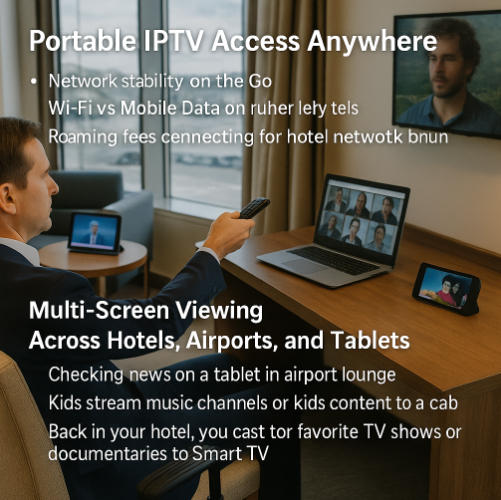
Multi-Screen Viewing Across Hotels, Airports, and Tablets
Watching IPTV across multiple screens during travel isn’t just a luxury — it’s become a business must.
You check the news on your tablet in the airport lounge.
Kids stream music channels or kids content from your smartphone in the backseat of the cab.
Back in your hotel, you cast your favorite TV shows or documentaries to the Smart TV.
It’s all about device compatibility. Tablets and phones handle most situations just fine, but some streaming devices struggle with unstable hotel Wi-Fi. The key here?
Use IPTV apps that sync across devices.
Look for services with high streaming quality regardless of screen size.
Bonus points if you can start a movie in the airport and pick up right where you left off in your room.
Smooth user experience matters. No one wants to fumble with logins or restart episodes mid-flight.
Conclusion
Finding the right IPTV service is kind of like picking a car — you don’t just look at the paint job. You care about what’s under the hood. The best IPTV service is the one that delivers solid content, smooth performance, and fits your needs like a glove. As tech journalist Kara Swisher once said, “The future belongs to those who get digital right.” That’s where your choice matters.
Here’s your quick-fire checklist:
• Offers sports, kids, movies, and news content
• Supports Smart TVs, phones, and streaming boxes
• Comes with VOD, DVR, and parental controls
• Keeps buffering low and picture quality high
• Clear pricing with zero hidden fees
When all is said and done, the best IPTV service isn’t the flashiest — it’s the one your customers don’t have to think twice about. If you’re ready to compare plans or try before you buy, head to our IPTV subscription page or grab an IPTV free trial. For deeper due-diligence, see our take on scams and reviews: Is IPTV a scam? / IPTV service review.
